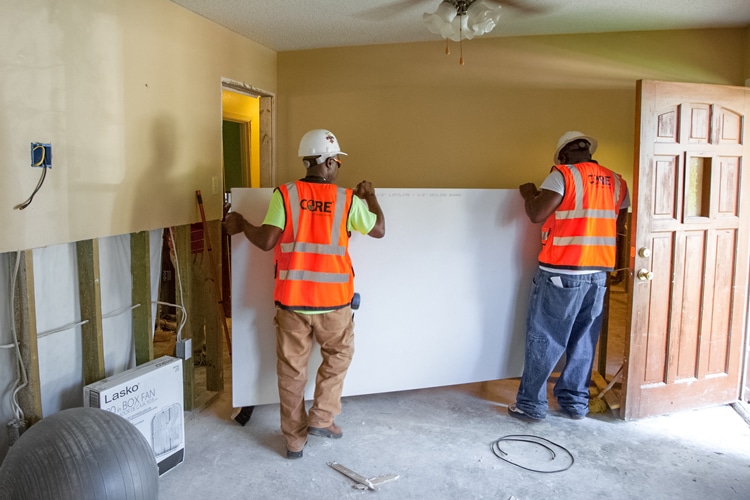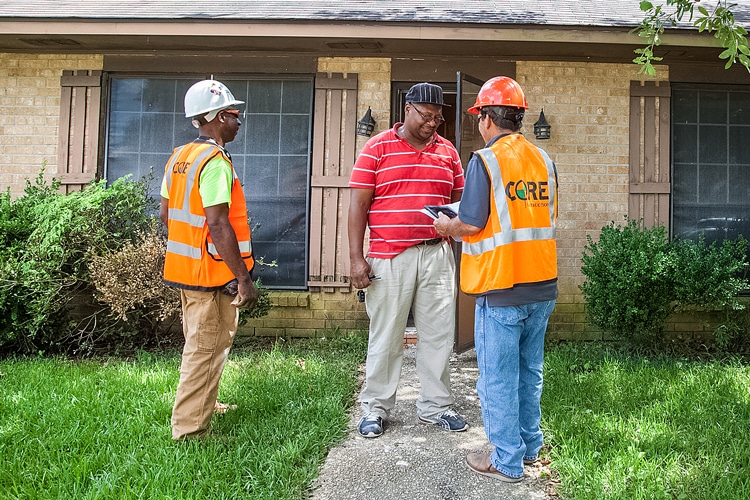Briefly:
- Louisiana’s Shelter at Home program restored livable conditions to Baton Rouge flood victims while full repairs were conducted and infrastructure was rebuilt
- CORE Construction participated in the program and surveyed over 1900 homes and worked with FEMA’s inspectors to write on-the-spot recommendations for repairs
- Each property had a $15k limit so each scope of work recommendation had to be accurate
- With how quickly work needed to be completed and information needed to be shared all data had to be captured electronically, and each home had up to 72 unique Scopes of Work
- CORE used Bluebeam Studio API to manage thousands of documents and complete a complex data migration task
- Using Bluebeam Revu and the Bluebeam Studio API enabled CORE to process as many as 100 property inspections per day for more than 100 days, yielding over 500,000 pieces of data
Many in the United States remember the horrors of Hurricane Katrina, one of the worst natural disasters to strike the country in its history. Unfortunately, the State of Louisiana has always dealt with rains, floods and hurricanes, but the scale of that particular storm brought with it powerful lessons regarding clean up and neighborhood restoration. These lessons were put to the test on August 12, 2016 when a disastrous rainstorm engulfed thousands of homes in greater Baton Rouge, Louisiana area.

As relief efforts began, CORE Construction was selected to assist the area as part of the State of Louisiana’s FEMA funded Shelter at Home program. The program evaluated each applicant’s home and, if up to $15,000 of work in that home would establish a safe, secure, habitable place for the family to live while they continued their permanent home rebuilding, then that applicant was eligible for the program. Initial work included mucking out the house, basic electrical restoration, installing a suitable water heater, removing wet wall insulation, and providing up to $500 in cooking or refrigerating appliances. This work was provided at no out-of-pocket cost to the eligible homeowner, and was independent of any Individual Assistance grant from FEMA. These essential emergency cleanup and minor repairs helped families get a jumpstart on their full recovery and live in at least a portion of their home, while they continued to finish the big task of making permanent repairs to their home.
The Challenge
- All data needed to be captured electronically – each home had up to 72 SOWs (Scope of Work) plus ID info
- Limited Internet Connectivity
- Each home was only allotted up to $15k for all repairs—CORE had to commit to all SOWs on the spot and data needed to be precise to stay under $15k total
- About 1400 homes needed to be finished in less than four months
The Tech Stack
- Bluebeam Revu
- Bluebeam Revu for iPad
- Bluebeam Studio API
- Microsoft Azure SQL
- Microsoft Azure Automation
The Process: A Summary
CORE utilized the Studio API to manage thousands of documents and complete a complex data migration task quickly and efficiently. This process entailed using the FEMA-provided form to create CORE’s own PDF form, consisting of four legal-sized pages with 390+ form fields and four types of fields: text box, dropdown, button, and radio button. These forms were then used for all 1900 total inspections. Since CORE had to commit to the SOWs on the fly, the info in the forms had to be completely accurate in order to make sure the costs per inspection would not exceed $15k.
“Without Bluebeam, this project would not have been a success.” – Gary Aanenson, Construction Technology Manager, CORE Construction

Automating Form Data Extraction
The team at CORE created scripts using the Bluebeam Studio API to connect to the Bluebeam Studio Project, scan through all PDFs within folders where inspectors would save their completed inspections for the day, and read the revision history on those PDFs. If the revision history indicated that it had not been processed yet, then the process would kick off jobs to extract form data for each PDF (Portable Document Format) to CSV (comma-separated values). The process would then monitor the jobs, waiting for them to all complete, then retrieve all of the CSVs, read them up into memory, create queries to write all the data to CORE’s database, and fire off all the queries to write to the database.
Once complete, the process would check that all the data was successfully written, then go back and clear out the staging folder in Studio Project where the CSVs were extracted to, and finally, would check out/check in the corresponding PDF to write a comment (in their revision history) to indicate that the file was successfully processed. If for any reason, any files in the process hung up, had bad data or required intervention, then the process would trigger an email summary to Project Managers with the details they needed to correct the PDFs. Since the API generates tokens that periodically expire, the process also had to continually generate new authorization and refresh tokens to keep its access alive.
“Without the Studio API, we would have been forced to create a web application in order to gather the information efficiently. A web application is not something that can be developed over night, so using PDF forms and Studio’s API was the right answer. It was a solution that allowed us to act quickly and worked effectively for over 1,800 home inspections.” Gary Aanenson – Construction Technology Manager, CORE
“We had better information at our fingertips than the people who hired us to do the work.” – Dustin Burks, CIO, CORE Construction

The Result
Using Revu and the Studio API enabled CORE to process over 100 forms per day for more than 100 days, yielding over 500,000 pieces of data. Bluebeam solutions were used to scan completed PDF home inspection forms, run numerous scripts to analyze and export the data into a SQL database, validate the imported data, and move the processed forms into a new folder. With the flexibility of the PDF form creation in the Bluebeam Revu application as well as the capabilities of the Studio API, CORE was able to create an automated process to extract all of the information. Without this, CORE would have ended up with a manual process that would have taken much more manpower to complete, and likely left many residents homeless and looking for emergency shelters or churches. Instead, CORE was able to use technology to help residents of over 1800 structures keep their homes and families intact while the intense community rebuilding took place.















